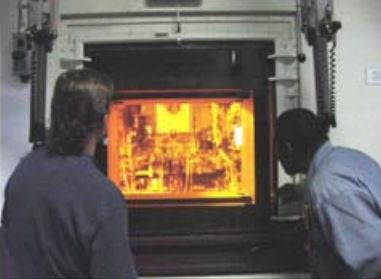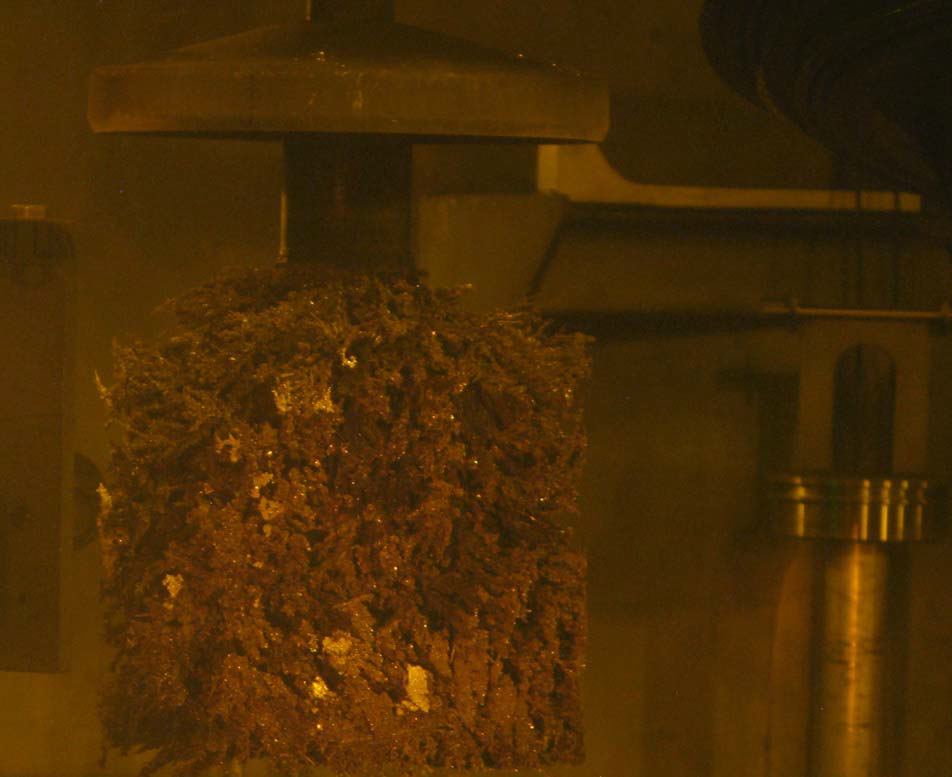The article by Ralph Vartabedian in the Los Angeles Times highlights the failure of the Department of Energy’s decades-long effort to chemically process a stockpile of spent nuclear fuel at Idaho National Laboratory, ostensibly to convert the waste to forms that would be safer for disposal in a geologic repository. A secondary goal was to demonstrate the viability of a new type of processing spent fuel—so-called pyroprocessing. Instead, it has demonstrated the numerous shortcomings of this technology.

(Source: Idaho National Lab)
It is particularly important to disseminate accurate information about the failure of this DOE program to dispel some of the myths about pyroprocessing. The concept of the “Integral Fast Reactor”—a metal-fueled fast neutron reactor with co-located pyroprocessing and fuel fabrication facilities—has attracted numerous staunch advocates.
In addition to Argonne National Laboratory, which first developed the technology, the concept has been promoted in the popular media (most notably in the 2013 documentary Pandora’s Promise) and by GE-Hitachi, which seeks to commercialize a similar system. South Korea has long sought to be able to implement the technology, and countries such as China, Japan and Russia all have expressed interest in pursuing it. But this interest has been driven largely by idealized studies on paper and not by facts derived from actual experience.
DOE internal documents reveal problems
The LA Times article refers to a paper I presented to an international conference in June that draws on documents that UCS received in response to a Freedom of Information Act (FOIA) request. UCS initiated the request in 2015 to seek information that could shed light on DOE’s troubled program for pyroprocessing 26 metric tons of “sodium-bonded” metallic spent fuel from the shutdown Experimental Breeder Reactor-II (EBR-II).
Pyroprocessing is a form of spent fuel reprocessing that dissolves metal-based spent fuel in a molten salt bath (as distinguished from conventional reprocessing, which dissolves spent fuel in water-based acid solutions). Understandably, given all its problems, DOE has been reluctant to release public information on this program, which has largely operated under the radar since 2000.
The FOIA documents we obtained have revealed yet another DOE tale of vast sums of public money being wasted on an unproven technology that has fallen far short of the unrealistic projections that DOE used to sell the project to Congress, the state of Idaho and the public. However, it is not too late to pull the plug on this program, and potentially save taxpayers hundreds of millions of dollars.
History of the pyroprocessing program
DOE originally initiated the pyroprocessing program for EBR-II spent fuel in the mid-1990s as a consolation prize to Argonne-West National Laboratory (now part of present-day Idaho National Laboratory) after it cancelled the Integral Fast Reactor (IFR) program. The idea was that the metal-based spent fuel from the reactor could be pyroprocessed in a facility connected to the reactor, which would extract plutonium, uranium and other elements to be fabricated into new reactor fuel. In theory, this could be a system that could convert its nuclear waste into usable fuel on site and thus could be largely self-contained. Pyroprocessing was billed as a simpler, cheaper and more compact alternative to the conventional aqueous reprocessing plants that have been operated in France, the United Kingdom, Japan and other countries.
Although DOE shut down the EBR-II in 1994 (the reactor part of the IFR program), it allowed work at the pyroprocessing facility to proceed. It justified this by asserting that the leftover spent fuel from the EBR-II could not be directly disposed of in the planned Yucca Mountain repository because of the potential safety issues associated with presence of metallic sodium in the spent fuel elements, which was used to “bond” the fuel to the metallic cladding that encased it. (Metallic sodium reacts violently with water and air.)
Pyroprocessing would separate the sodium from other spent fuel constituents and neutralize it. DOE decided in 2000 to use pyroprocessing for the entire inventory of leftover EBR-II spent fuel – both “driver” and “blanket” fuel – even though it acknowledged that there were simpler methods to remove the sodium from the lightly irradiated blanket fuel, which constituted nearly 90% of the inventory.
Little progress, big cost overruns
However, as the FOIA documents reveal in detail, the pyroprocessing technology simply has not worked well and has fallen far short of initial predictions (Figure 1) (Refs. 1-3). Although DOE initially claimed that the entire inventory would be processed by 2007, as of the end of Fiscal Year 2016, only about 15% of the roughly 26 metric tons of spent fuel had been processed. Over $210 million has been spent, at an average cost of around $50,000 per kilogram of fuel treated. At this rate, it will take until the end of the century to complete pyroprocessing of the entire inventory, at an additional cost of over $1 billion.
But even that assumes, unrealistically, that the equipment will continue to be usable for this extended time period. Moreover, there is a significant fraction of spent fuel in storage that has degraded and may not be a candidate for pyroprocessing in any event (Ref. 4). The long time to completion is problematic because DOE has an agreement with the state of Idaho to remove all spent fuel from the state by the year 2035. The FOIA documents reveal that DOE is well aware that it is not on track to comply with this obligation (Ref 5). Yet DOE has not made any public statements to that effect and continues to insist that it can meet the deadline.
More waste, not less

An impure uranium waste product is deposited on a cathode in a pyroprocessing cell (Source: Idaho National Lab)
What exactly is the pyroprocessing of this fuel accomplishing? Instead of making management and disposal of the spent fuel simpler and safer, it has created an even bigger mess. Pyroprocessing separates the spent fuel into three principal waste streams. The first is an enriched uranium metal material called the “spent fuel treatment product.” Because this material contains unacceptably high levels of plutonium and other contaminants, the uranium cannot be used to make new nuclear fuel unless it is further purified; thus it is a waste product. Meanwhile, the material is accumulating and taking up precious space at INL storage facilities, causing its own safety issues.
The second waste stream is the molten salt bath that is used to dissolve the spent fuel. Fission products and plutonium have accumulated in this salt for 20 years. Eventually it will have to be removed and safely disposed of. But for various reasons—including cost and a lack of available space for the necessary equipment—INL is reconsidering the original plan to convert this waste into a stable ceramic waste form. Instead, it may just allow it to cool until it hardens and then directly dispose of it in the Waste Isolation Pilot Plant (WIPP) in New Mexico (Ref. 6).
The third waste stream consists of the leftover metal cladding tubes that encased the nuclear fuel, and the metal plenums that extended above the fuel region, which are contaminated with fission products and sodium. The original plan was to convert these scraps into a stable, homogeneous waste form. But the FOIA documents reveal that DOE is also reconsidering this plan, and considering redefining this material as transuranic or low-level waste so it could be disposed of without further processing in WIPP or a low-level radioactive waste disposal facility. Storage of the accumulating metal scrap material is also becoming an increasing burden at INL (Ref. 7).
In other words, pyroprocessing has taken one potentially difficult form of nuclear waste and converted it into multiple challenging forms of nuclear waste. DOE has spent hundreds of millions of dollars only to magnify, rather than simplify, the waste problem. This is especially outrageous in light of other FOIA documents that indicate that DOE never definitively concluded that the sodium-bonded spent fuel was unsafe to directly dispose of in the first place. But it insisted on pursuing pyroprocessing rather than conducting studies that might have shown it was unnecessary.
Everyone with an interest in pyroprocessing should reassess their views given the real-world problems experienced in implementing the technology over the last 20 years at INL. They should also note that the variant of the process being used to treat the EBR-II spent fuel is less complex than the process that would be needed to extract plutonium and other actinides to produce fresh fuel for fast reactors. In other words, the technology is a long way from being demonstrated as a practical approach for electricity production. It makes much more sense to pursue improvements in once-through nuclear power systems than to waste any more time and money on reprocessing technologies that pose proliferation, security and safety risks. DOE continues to consider alternatives to pyroprocessing for the blanket fuel (Ref. 8). It should give serious thought to the possibility of direct disposal of the remaining inventory without processing.
Links to FOIA documents
Below are links to some of the documents that UCS obtained from its FOIA request. We will provide more documents and analyses of them soon.
- Argonne National Laboratory Spent Fuel Treatment Implementation Plan (2000)
- INL Preferred Disposition Plan for Sodium-Bonded Spent Nuclear Fuel (2007)
- History of Processing (through 2013)
- Technical Evaluation of Disposition of Non-Candidate Fuels (2014)
- 2014 INL Environmental Liabilities Spreadsheet
- Technical Evaluation of Alternatives for Salt Waste Disposition (2014)
- Disposal Solutions for Metal Scraps Derived from Treatment of Irradiated Sodium Bonded Fuel (2014)
- Technical Evaluation of EBR-II Blanket Disposition Alternatives (2014)
